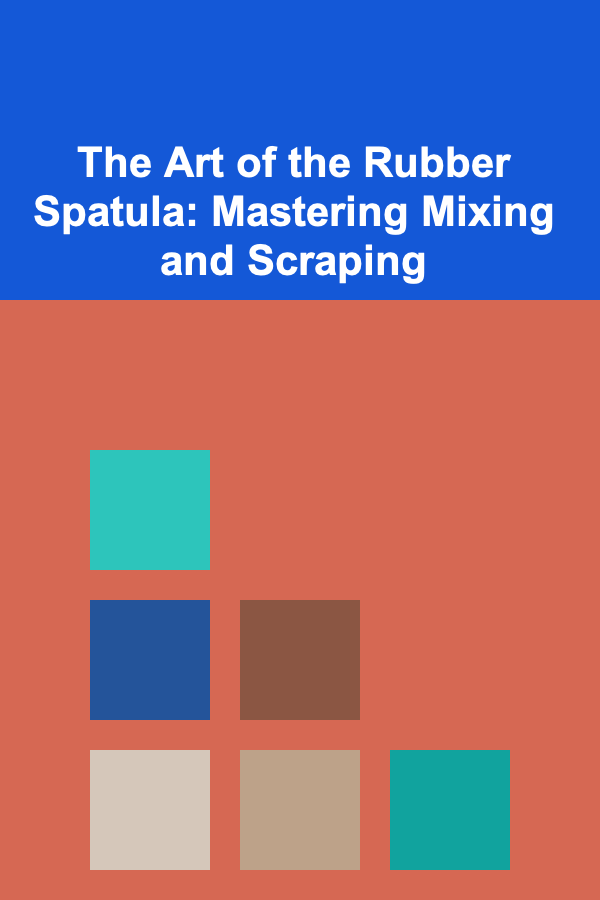
The Art of the Rubber Spatula: Mastering Mixing and Scraping
ebook include PDF & Audio bundle (Micro Guide)
$12.99$7.99
Limited Time Offer! Order within the next:

The humble rubber spatula, often overlooked in the dazzling array of kitchen gadgets, is a cornerstone of efficient cooking and baking. More than just a tool for scraping bowls, it's a versatile instrument capable of delicate mixing, thorough ingredient incorporation, and precise application. Mastering the rubber spatula is about understanding its design, choosing the right type for the task, and developing techniques that optimize its performance. This article will delve into the nuances of using a rubber spatula effectively, transforming you from a novice to a spatula savant.
Understanding the Anatomy of a Rubber Spatula
To truly appreciate the rubber spatula, it's essential to understand its components and how they contribute to its overall function. The typical rubber spatula consists of two main parts: the blade (or head) and the handle. The blade is the flexible, usually silicone or rubber, portion that comes into direct contact with the food. The handle provides grip and control, allowing you to maneuver the blade with precision.
The Blade: Material, Shape, and Flexibility
The blade is the heart of the spatula, and its properties directly impact its effectiveness. Consider these factors:
- Material: Silicone and rubber are the most common materials. Silicone spatulas are generally heat-resistant (up to 400-600°F, depending on the quality), making them ideal for cooking on the stovetop or in hot pans. Rubber spatulas, particularly those made from natural rubber, may have lower heat resistance and are better suited for mixing cold or room-temperature ingredients.
- Shape: Spatula blades come in various shapes:
- Flat/Straight-edged: Excellent for scraping bowls, spreading frosting, and leveling surfaces.
- Curved: Ideal for folding ingredients and reaching into curved surfaces.
- Offset: Provide better leverage and control, especially when spreading frosting or icing.
- Spoon-shaped: Designed for scooping and serving sauces, stews, and other liquids.
- Flexibility: The flexibility of the blade determines how well it conforms to the shape of the bowl or pan. A very flexible blade is excellent for scraping, while a stiffer blade is better for stirring and folding heavier ingredients. Look for a balance that suits your needs. Some spatulas have a slightly stiffer core inside the silicone to give more support.
The Handle: Grip, Length, and Durability
The handle is just as crucial as the blade, ensuring comfortable and controlled handling.
- Grip: Choose a handle with a comfortable grip that won't slip, even when your hands are wet or greasy. Look for materials like silicone or rubber, or handles with textured surfaces.
- Length: Handle length affects reach and leverage. A longer handle is useful for reaching into deep pots or bowls, while a shorter handle provides more control for delicate tasks.
- Durability: The handle should be sturdy and well-attached to the blade. Look for spatulas with handles that are reinforced or have a seamless connection to the blade to prevent breaking or loosening over time. Consider a one-piece construction for maximum durability and hygiene.
Choosing the Right Spatula for the Task
Just as you wouldn't use a screwdriver to hammer a nail, you shouldn't use the same spatula for every task. Selecting the appropriate spatula for the job significantly impacts the outcome.
For Scraping Bowls and Pans: The Flexible Flat Spatula
A flexible, flat-edged silicone spatula is the undisputed champion of scraping. Its thin, flexible blade can effortlessly glide along the contours of bowls and pans, ensuring that no precious batter, sauce, or ingredient is left behind. This is especially crucial when baking, where accurately measuring ingredients and incorporating them fully is essential for success. The flexibility allows it to get into tight corners and under rims.
For Folding Ingredients: The Curved or Angled Spatula
Folding is a delicate technique used to incorporate light, airy ingredients (like whipped cream or beaten egg whites) into heavier mixtures without deflating them. A curved or angled spatula is ideal for this task. The curve helps to gently lift the mixture from the bottom of the bowl and fold it over the lighter ingredients, preserving their volume.
For Mixing and Stirring: The Sturdy, All-Purpose Spatula
For general mixing and stirring, a sturdy spatula with a slightly stiffer blade is your go-to tool. This type of spatula can handle heavier ingredients and thicker mixtures without bending or breaking. It's perfect for creaming butter and sugar, mixing cookie dough, or stirring sauces on the stovetop.
For Spreading Frosting and Icing: The Offset Spatula
An offset spatula, with its angled blade, provides superior leverage and control when spreading frosting or icing on cakes and cupcakes. The angle allows you to keep your hand away from the frosting, preventing smudging and creating a smooth, even surface. Using different sized offset spatulas can allow for fine detail work. Consider also using it for spreading fillings in layer cakes.
For High-Heat Cooking: The High-Heat Silicone Spatula
When cooking on the stovetop or in a hot pan, a high-heat silicone spatula is essential. These spatulas are designed to withstand temperatures up to 400-600°F without melting or degrading. They are perfect for stirring sauces, sautéing vegetables, and scraping the bottom of pans to prevent sticking.
Mastering Spatula Techniques: Beyond Scraping
While scraping is a fundamental skill, the rubber spatula is capable of so much more. Here are some essential techniques to elevate your spatula game:
The Art of Scraping: Minimizing Waste and Maximizing Efficiency
Scraping isn't just about removing leftover food; it's about maximizing efficiency and minimizing waste. A clean scrape can mean the difference between a perfectly portioned recipe and a slightly under- or over-filled one. Here's how to scrape like a pro:
- Choose the right spatula: A flexible, flat-edged spatula is best for scraping bowls and pans.
- Start at the edges: Begin by scraping down the sides of the bowl or pan, working your way towards the center.
- Apply consistent pressure: Maintain even pressure as you move the spatula along the surface to ensure that you're picking up all the remaining ingredients.
- Angle the spatula: Angle the spatula slightly to create a clean, even scrape.
- Don't be afraid to go back: If you missed a spot, don't hesitate to go back and scrape it again.
- Clean as you go: Periodically wipe the spatula clean with a damp cloth or paper towel to prevent buildup and ensure a clean scrape.
Folding: Preserving Air and Lightness
Folding is a delicate technique used to incorporate light, airy ingredients (like whipped cream or beaten egg whites) into heavier mixtures without deflating them. The goal is to maintain the volume and texture of the lighter ingredients, resulting in a light and airy final product.
- Add a small amount of the heavier mixture to the lighter mixture: This helps to temper the lighter mixture and make it more resistant to deflation.
- Use a curved or angled spatula: The curve helps to gently lift the mixture from the bottom of the bowl and fold it over the lighter ingredients.
- Cut down the center: Insert the spatula vertically into the center of the bowl, cutting down to the bottom.
- Lift and fold: Gently lift the spatula from the bottom of the bowl, scooping up some of the heavier mixture, and fold it over the lighter ingredients.
- Rotate the bowl: Rotate the bowl slightly and repeat the cutting, lifting, and folding motion.
- Work quickly and gently: Avoid overmixing, as this can deflate the lighter ingredients.
- Stop when just combined: The mixture should be just combined, with no streaks of the lighter ingredients remaining. A few small streaks are fine.
Creaming: Achieving a Light and Fluffy Texture
Creaming butter and sugar is a fundamental technique in baking, used to create a light and fluffy texture in cakes, cookies, and other treats. The goal is to incorporate air into the butter and sugar, creating a stable emulsion that will result in a tender and moist final product. A rubber spatula plays a crucial role in ensuring all the butter and sugar are evenly incorporated.
- Use softened butter: The butter should be softened but not melted. It should be soft enough to press your finger into easily, but still hold its shape.
- Add the sugar: Add the sugar to the softened butter.
- Cream together: Use a sturdy spatula to cream the butter and sugar together until light and fluffy. This can take several minutes, so be patient.
- Scrape the bowl: Periodically scrape down the sides and bottom of the bowl to ensure that all the butter and sugar are evenly incorporated. The spatula's ability to fully scrape the bowl is key here.
- Look for a change in color and texture: The mixture should lighten in color and become fluffy in texture.
Smoothing Frosting: Achieving a Professional Finish
A smooth, even layer of frosting can transform a simple cake into a work of art. An offset spatula is your best friend for this task.
- Apply a crumb coat: Start by applying a thin layer of frosting to the cake to trap any loose crumbs. This is called a crumb coat.
- Chill the crumb coat: Chill the cake in the refrigerator for at least 30 minutes to allow the crumb coat to set.
- Apply the final layer of frosting: Apply a generous layer of frosting to the cake.
- Smooth the frosting: Use an offset spatula to smooth the frosting. Hold the spatula at a slight angle and gently glide it across the surface of the cake.
- Remove excess frosting: Periodically remove excess frosting from the spatula with a clean cloth or paper towel.
- Create a smooth finish: To create a smooth finish, dip the spatula in hot water and dry it with a clean cloth. Then, gently glide the spatula across the surface of the frosting.
- Practice makes perfect: Smoothing frosting takes practice, so don't be discouraged if you don't get it perfect the first time.
Deglazing: Capturing Flavor from the Pan
Deglazing is a technique used to dissolve the flavorful browned bits (fond) that stick to the bottom of a pan after cooking meat or vegetables. These bits are packed with flavor, and deglazing allows you to incorporate them into a sauce or gravy. A silicone spatula with a heat resistance that can be used safely is ideal here.
- Remove the meat or vegetables: After cooking the meat or vegetables, remove them from the pan and set them aside.
- Add liquid: Add a liquid to the pan, such as wine, broth, or water.
- Scrape the bottom of the pan: Use a heat-resistant spatula to scrape the bottom of the pan, loosening the browned bits.
- Simmer the liquid: Simmer the liquid for a few minutes, allowing the flavors to meld together.
- Adjust the seasoning: Adjust the seasoning to taste.
Caring for Your Rubber Spatulas
Proper care and maintenance will extend the life of your rubber spatulas and ensure that they perform optimally. This includes cleaning, storage, and knowing when it's time to replace a spatula.
Cleaning
Most rubber spatulas are dishwasher-safe, but hand washing is generally recommended to prolong their lifespan. Use warm, soapy water and a soft sponge or cloth to clean the spatula. Avoid using abrasive cleaners or scouring pads, as these can damage the surface of the blade and handle. Pay particular attention to the area where the blade meets the handle, as food particles can accumulate there. Thoroughly dry the spatula before storing it.
Storage
Store your rubber spatulas in a drawer or utensil holder away from direct sunlight and heat. Avoid overcrowding the drawer or holder, as this can cause the spatulas to bend or break. Hanging spatulas on hooks is another good option, as it keeps them organized and easily accessible.
Replacing Your Spatulas
Even with proper care, rubber spatulas will eventually wear out. Replace your spatulas when the blade becomes cracked, torn, or discolored, or when the handle becomes loose or broken. Using damaged spatulas can compromise their performance and potentially contaminate food.
Troubleshooting Common Spatula Issues
Even experienced cooks sometimes encounter problems with their rubber spatulas. Here are some common issues and how to address them:
- Spatula melting: This usually happens when using a spatula that's not heat-resistant on a hot surface. Always use a high-heat silicone spatula for stovetop cooking.
- Spatula staining: Some foods, like tomato sauce or turmeric, can stain silicone spatulas. To minimize staining, wash the spatula immediately after use. You can also try soaking the spatula in a solution of baking soda and water.
- Spatula breaking: This can happen if the spatula is used to stir very thick or heavy mixtures. Choose a sturdy spatula with a reinforced handle for such tasks.
- Food sticking to the spatula: Make sure the spatula is clean and dry before using it. You can also lightly oil the spatula to prevent sticking.
Conclusion: The Rubber Spatula, a Culinary Essential
The rubber spatula is more than just a kitchen utensil; it's an extension of the cook's hand, a tool that enables precision, efficiency, and creativity in the kitchen. By understanding the different types of spatulas, mastering essential techniques, and providing proper care, you can unlock the full potential of this versatile tool and elevate your cooking and baking to new heights. From scraping the last bit of batter to gently folding in delicate ingredients, the rubber spatula is a silent partner in countless culinary creations. So, embrace the art of the rubber spatula and experience the difference it can make in your kitchen.

How to Handle Short-Term Rentals (e.g., Airbnb) Effectively
Read More
How to Renovate Your Kitchen for Maximum Efficiency
Read More
How to Stage a Home with Bold, Vibrant Colors
Read More
How To Identify Chekhov's Gun in Movies
Read More
Understanding the Future of Organ Transplants
Read More
How to Reduce Your Risk of Oral Health Issues
Read MoreOther Products

How to Handle Short-Term Rentals (e.g., Airbnb) Effectively
Read More
How to Renovate Your Kitchen for Maximum Efficiency
Read More
How to Stage a Home with Bold, Vibrant Colors
Read More
How To Identify Chekhov's Gun in Movies
Read More
Understanding the Future of Organ Transplants
Read More